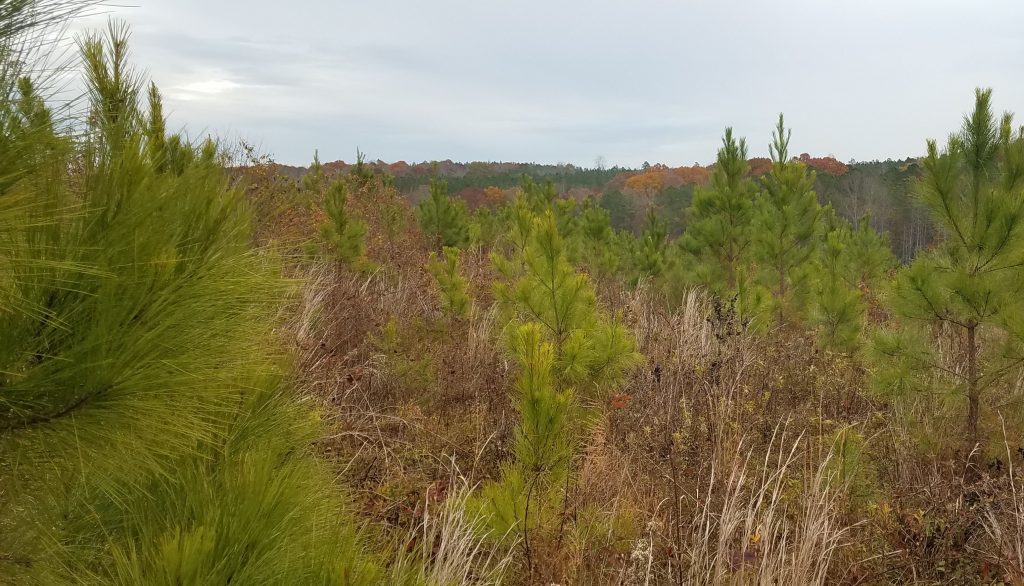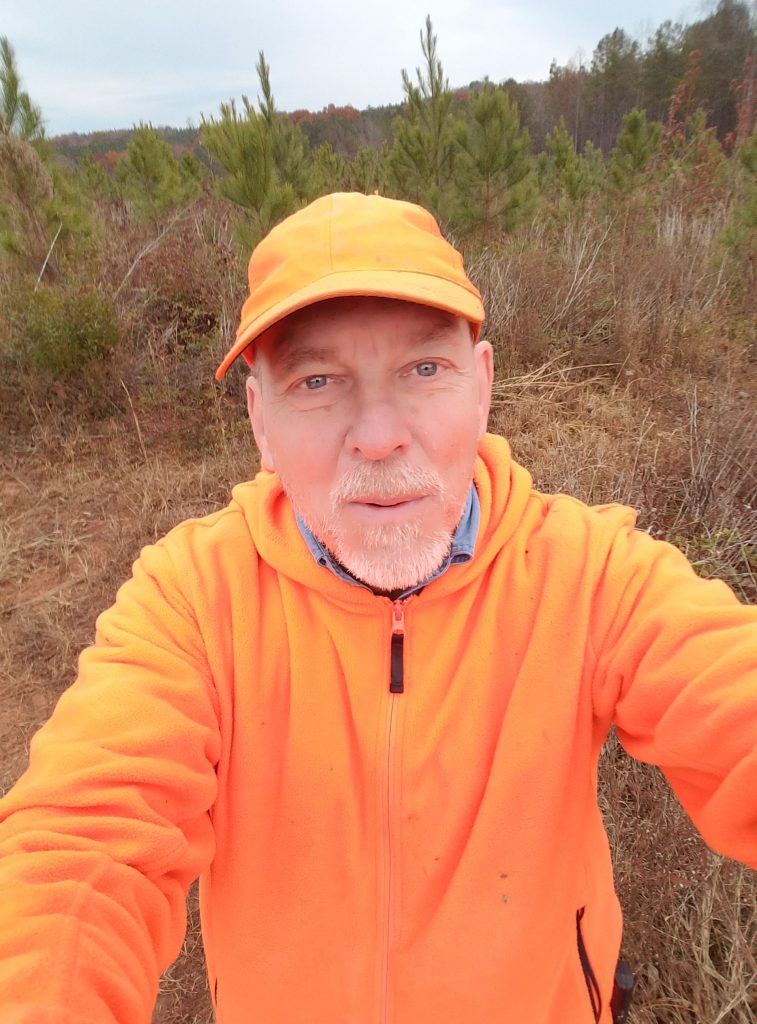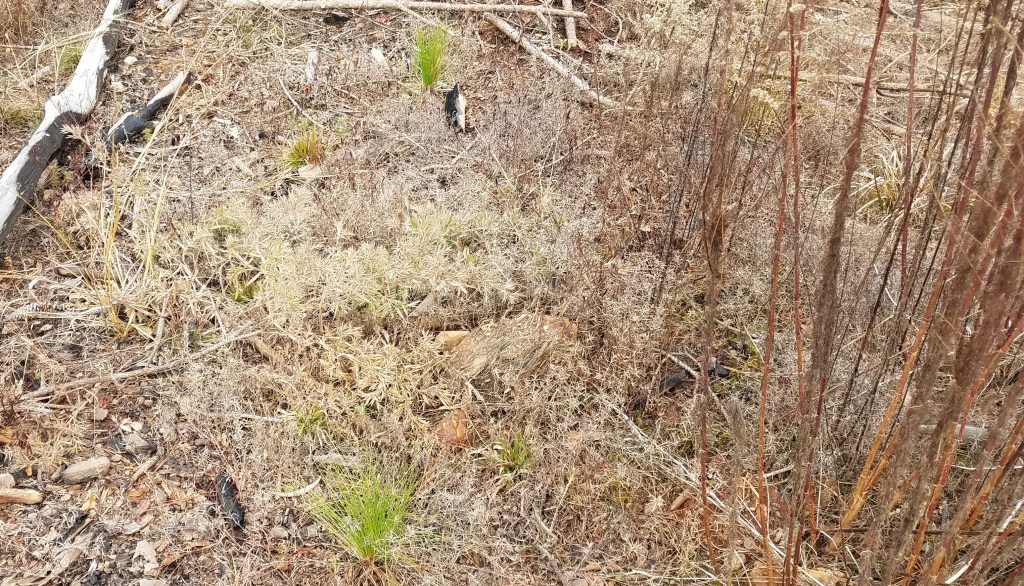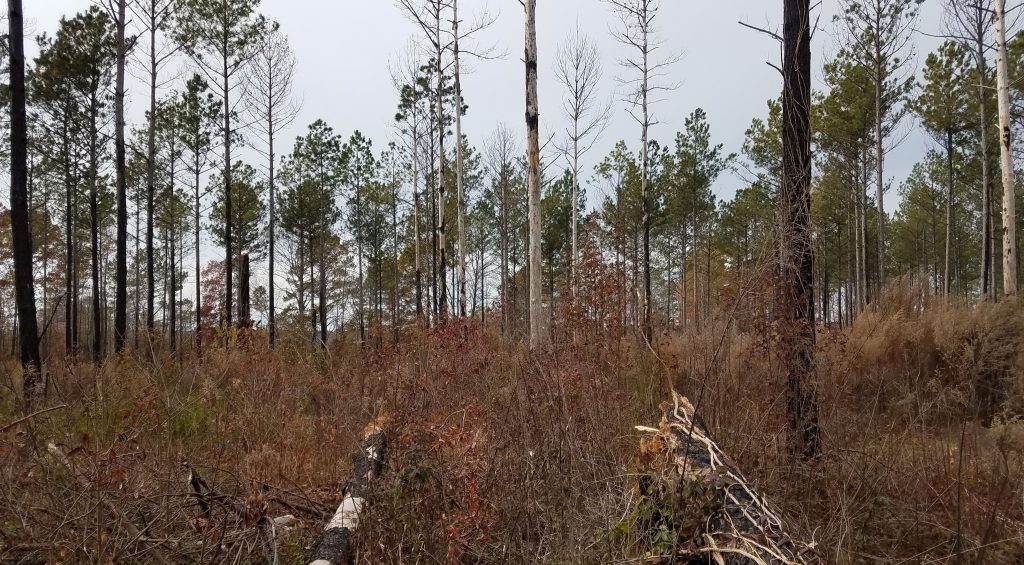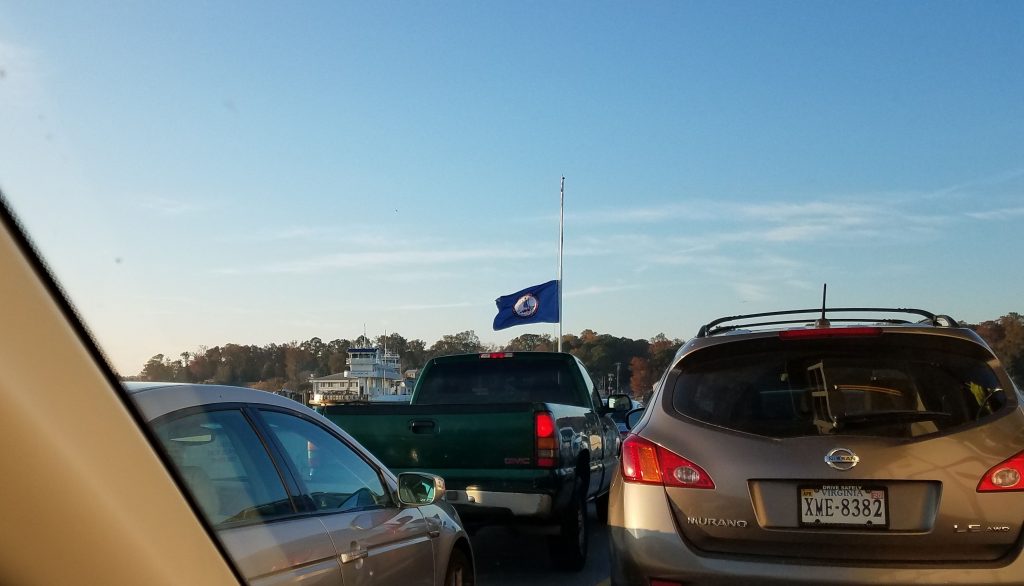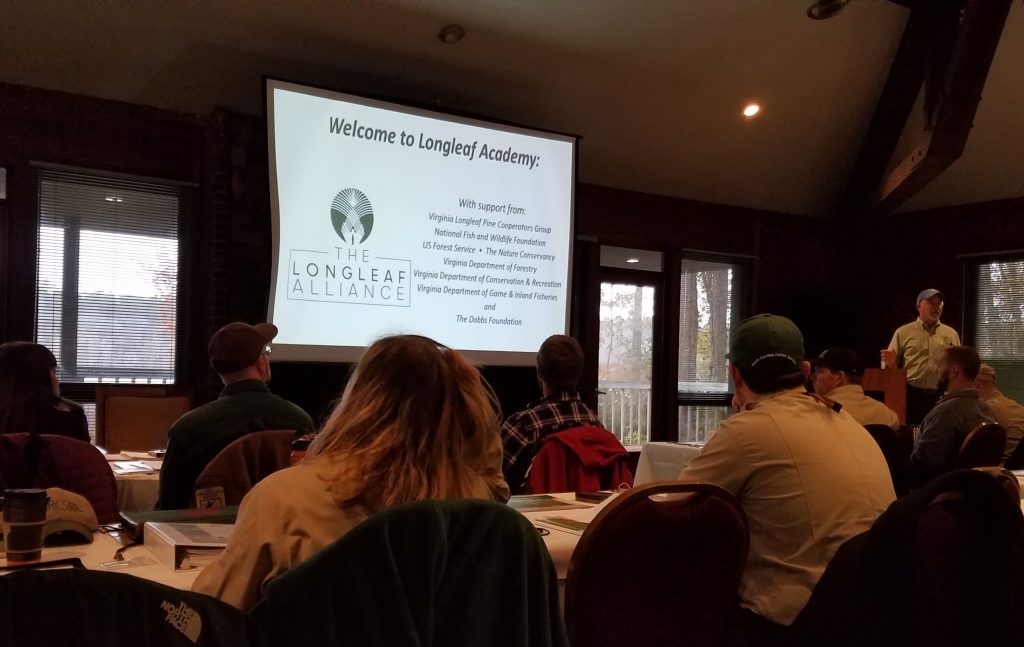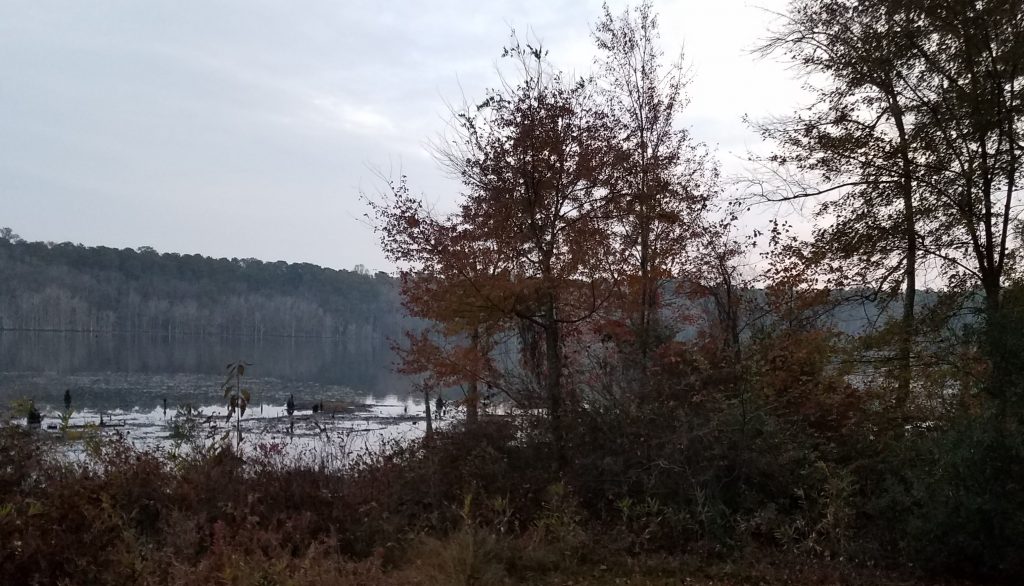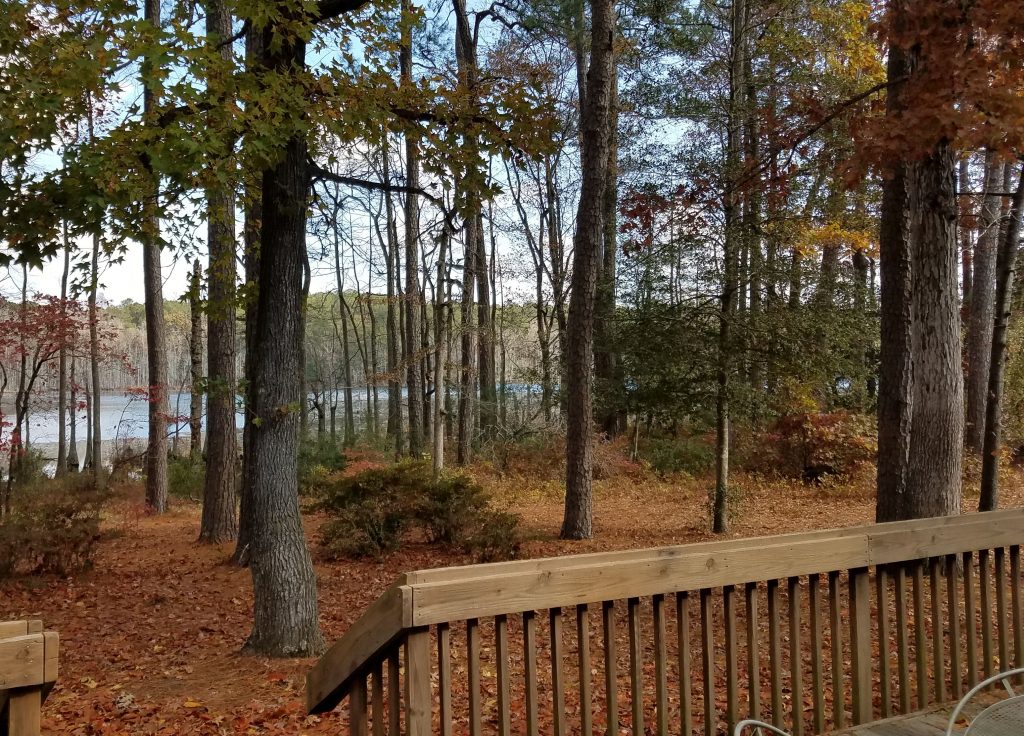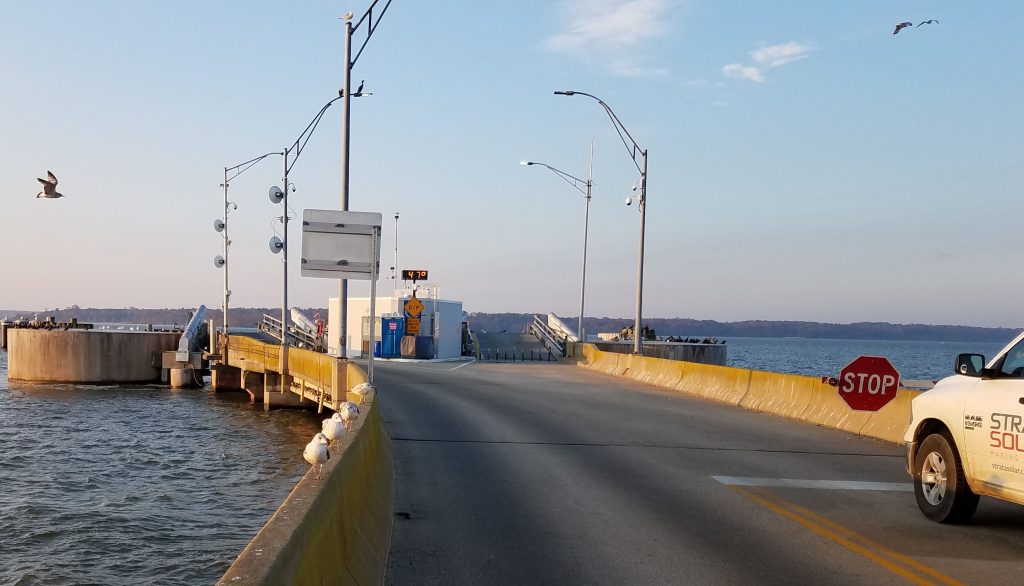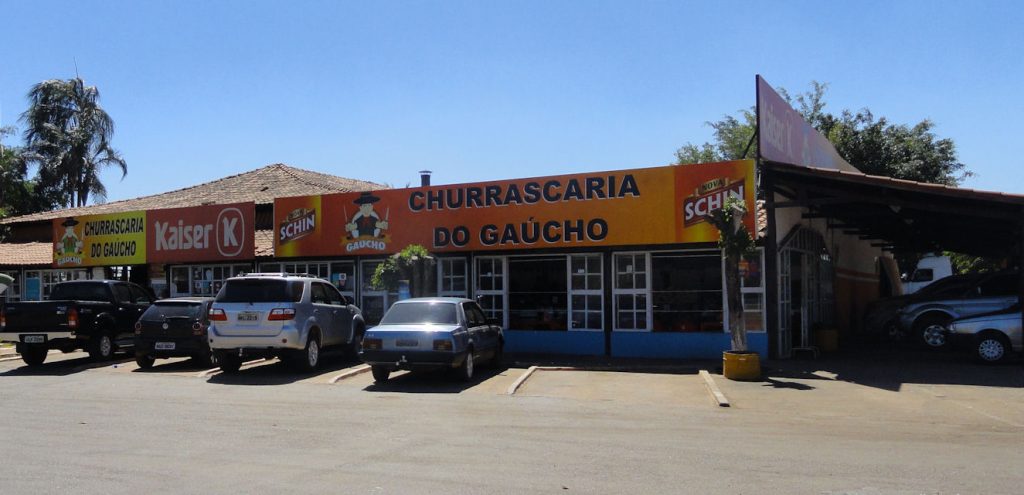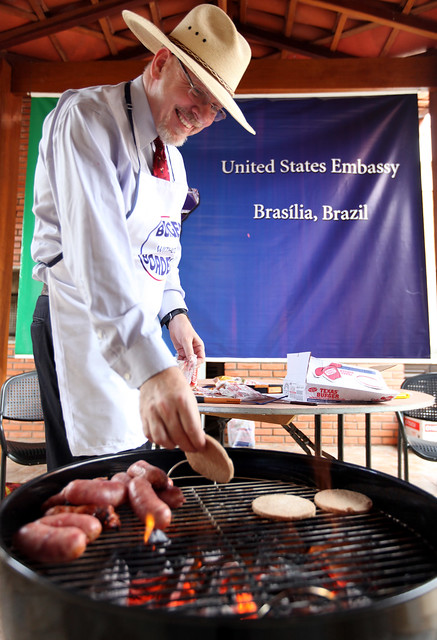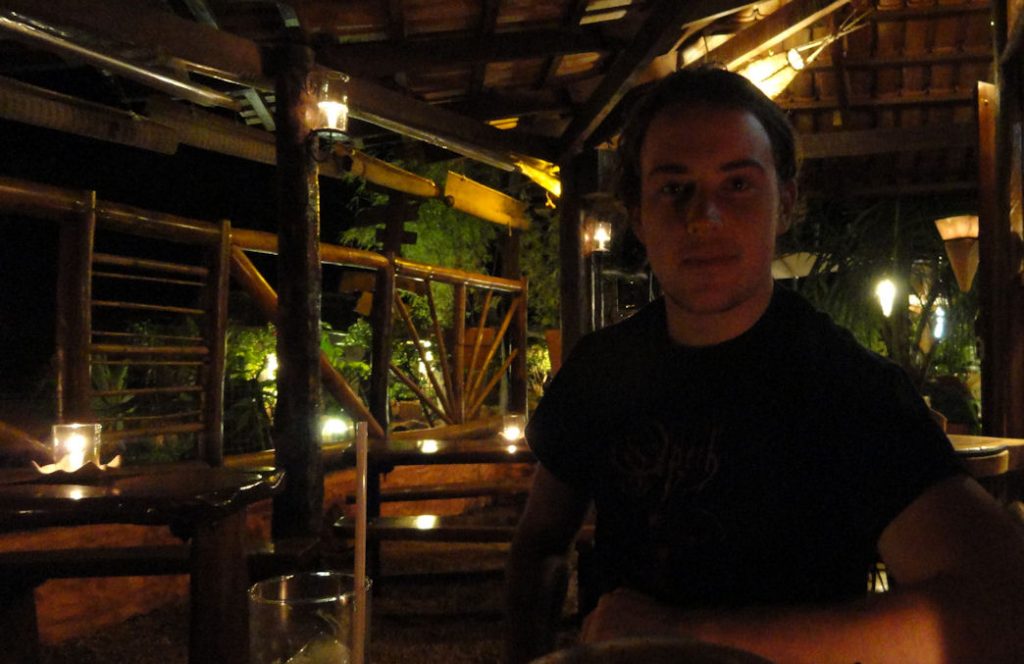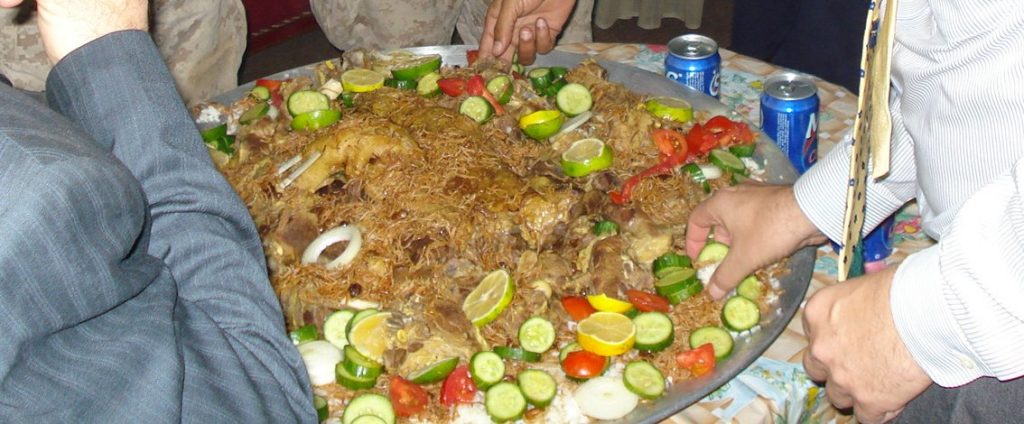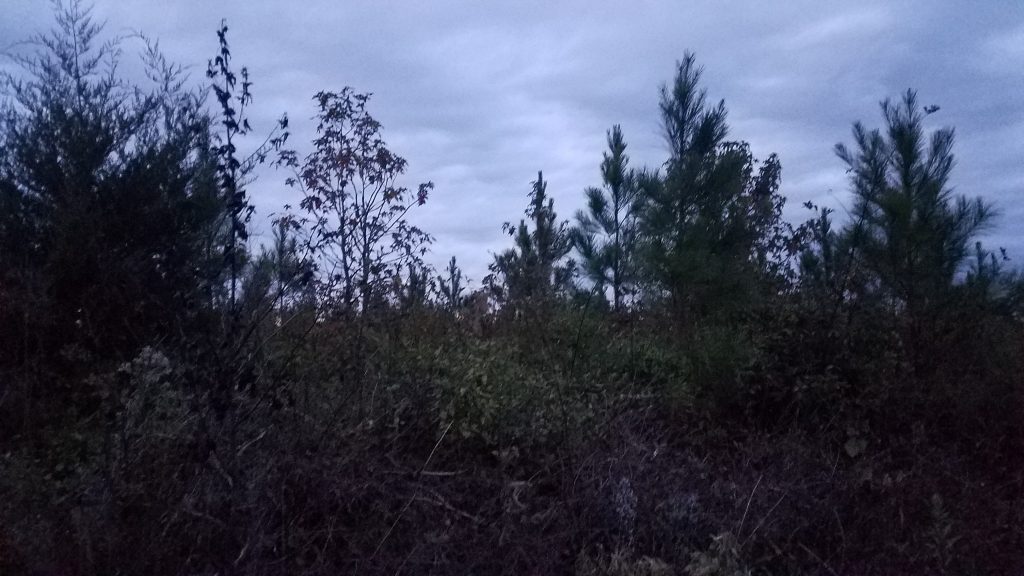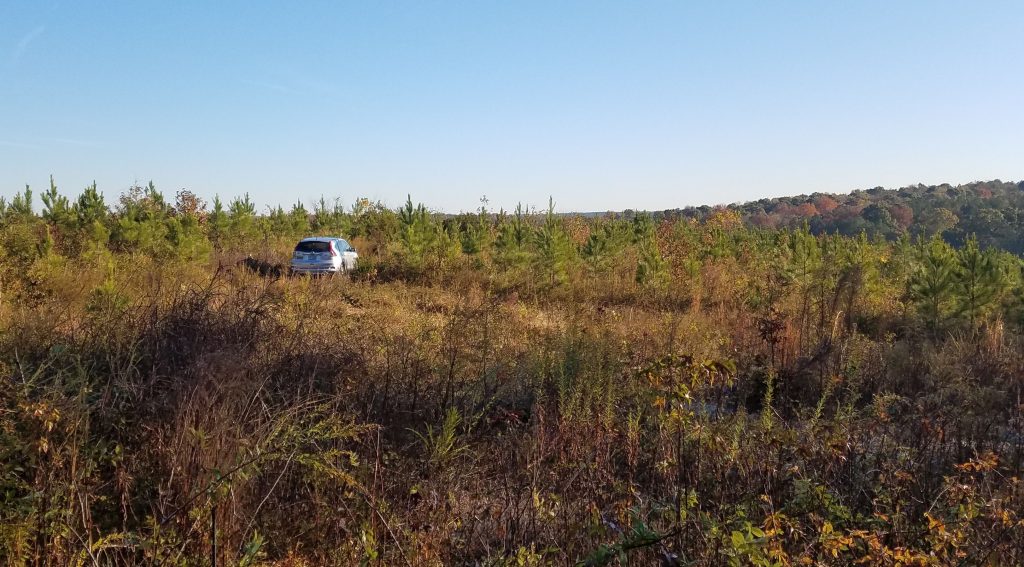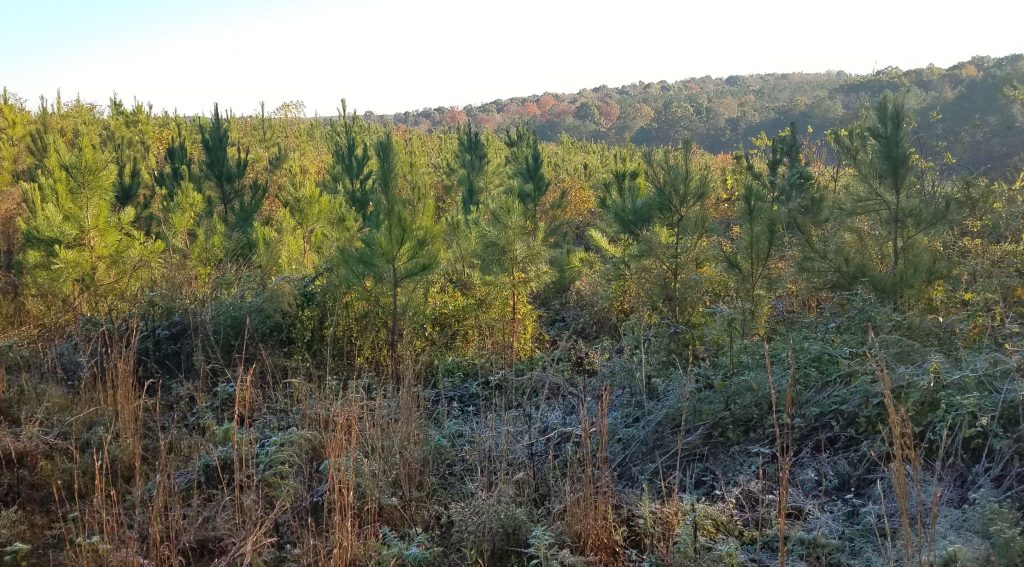Looking at the bright side, I have some great markers to plant my baby longleaf and to find them later on. Those benefits, unfortunately, result from dead trees falling down. Our May 2018 fire got a little hot in one section. I held out the hope that some of them would recover, so I treated my longleaf planting as an under planting.
Now that the bark has come off most of the trees and several have blown down, I think I can be reasonably sure that I should replant denser, assume it is an clearing.
I regret the loss of my trees, but I see it as an opportunity. What I have is a restoration project after a hot fire. I can imagine my little longleaf coming in under and among the burned out logs. I am also going to take advantage of natural regeneration of oak and shortleaf pine. I think this will become an interesting learning experience and I look forward to interacting with the changing land.
Given that I am treating this as an opening, I think I will need about 1000 trees and it will take me a couple days to get think in the ground. I am not as fast as the professionals, but I like the idea of doing it myself.
My first picture is me decked out in orange. It is hunting season, so good idea not to blend in with the bushes. Next three pictures show the future longleaf grove. Last is the panorama of loblolly. We planted them in 2016, so they are only four years old. Most are 6-8 feet tall. Good result. The reason I took the picture, however, was the beauty of the hardwoods in the background, showing their vibrant fall colors.
The most beautiful time to look at fall colors, IMO, is just before dusk. The colors show up better than in full light. I did not take a picture of that. No picture would do it justice.
Objectives for owning forest land
My Freeman farm was used as one of the case studies at the Longleaf Academy today and we talked about land management plans. Every good land management plan starts with landowner objectives. What do you want to do on your land? Why do you have land in the first place? I could easily explain what I wanted to do with my land, but the meta question – the purposes principle – why I had the land, that was a harder question.
Family tradition
Lots of landowners inherit their land. A big part of the purposes question is answered for them. It is the family. They are carrying on the tradition, stewarding the land they got from their grandparents for their grandchildren. I have only the second part of that equation, and it does give me satisfaction to think that my kids will somebody appreciate the land. Few of the things I do on the land will pay off fully in my lifetime. I like to think that my effort extends at least into the next generation. I like to think that when they contemplate the subliminal beauty of their own piece of nature, that they will remember me in it. This is both a selfish and a selfless sentiment. I choose to emphasize the latter.
The kids are willing to help. They planted trees last year and will do again. I am not sure they appreciate it all right now, but I am confident that they will
A story – we needed to spread some rip-rap to protect the stream bank on our Diamond Grove place and I needed the boys to help. For those unfamiliar with riprap, it is made up of rocks, most about the size of a basketball, but irregularly shaped. I bought twenty tons of riprap and had the truck driver drop it about twenty feet from the stream. I did this because I wanted the boys to “place” the rocks where the future stream should go, not just push them into the current one. Alex and Espen dutifully began to move the rocks. Hard work. After about two hours, one of them asked, don’t recall which, “couldn’t they have dropped the rocks a little closer to the stream?” I replied, “Sure, they could have done.” I like to think they thought that was funny. I am confident that they will someday look back and laugh. They did a good job, BTW. The rocks they placed support the natural bend in the stream, erosion is controlled and the water that passes over that spot flows clear and clean, unvexed on its way to the sea.
Community – natural & human
Another reason I own land developed after I got the land. Developed in interaction with the land and the biotic and the human communities on it. It was not my part of my plan because I didn’t know to plan it. I had a reasonable idea about the biotic communities from my long acquaintance with Aldo Leopold and the land ethic. It was the human community that surprised me. When I bought the land, I became an apprentice into a community. There was the community on the land itself, the guys at the hunt clubs and the neighbors who were so helpful. I feel that I have earned a place among them. I often run into community members on the land. Today, for example, I talked to the guys at the Reddy Creek Hunt Club. They were out hunting deer. Scott Powell got one. When on my way out, I saw Scott. I told him that I heard three shots, so assumed that they had bagged three deer. Scott said the first two shots were just to clear the shot.
We cooperate to make the land prosper for my forestry and their hunting and recreation. A prime piece of advice I would give to any absentee landowner is get a good hunt club. I am not sure I could comfortably own the land w/o them. I certainly would not with as much joy.
I accept my role. I suspect I provide stories, comic relief, but it is worth it. Last year I made the mistake of going down one of my muddy roads. I thought that all-wheel drive on my CRV could handle the mud and I was correct. Mud was not the factor. The problem was that my vehicle slipped off into two wonderfully parallel ditches. My SUV balanced on the middle with none of the wheels touching the ground. Your vehicle cannot move if the wheels do not contact the surface. I had a shovel, so I figured I could dig myself out. After about an hour, I gave up. Since much of my digging involved laying on the road and trying to dig into the road, I looked like a mud man. I called my local friends and a short time later they pulled me out, no doubt adding to local lore.
There is also the greater conservation community. I knew a lot of the people at the Longleaf Academy and they know me. We exchange information and experience, and many are friends, people I can count on. This means a lot to me. I think we all want to have a valued place in society. It need not be extraordinary. The simple rule is that is a lot of people would miss you if you were not there, you have a meaningful life.
When I contemplated retiring from the FS, I worried a lot about my identity. The great thing about retirement was that I was pulled into something I wanted, not pushed out. It has been great so far.
The triple bottom line
When I talked about landowner objectives in the Longleaf Academy, I mentioned the triple bottom line. Any successful enterprise must produce value for the community, i.e. good for people, for the environment, i.e. sustainable and better regenerative, and for the economy, i.e. it has to make money. Failing at any one of those bottom lines means that the enterprise is a failure. Succeeding at all three means success, even if none of the three is optimized. This I believe.
One more thing that gratifies me as I work on my land. When I first hatched the idea of buying forest land, it was objectively stupid. Who buys forest land? Certainly not some city boy with no actual experience with land buying, land owning or land working. Chrissy trusted me to make this buying decision and for that I am grateful and gratified. She must have had doubts, but she supported the “investment.” I am glad that I didn’t let her down. The land is not wildly profitable, but it neither is it a drain. The enterprise will break even, even if it does only after I am dead. I made it work on all three of the bottom lines and that is important to me.
Meaning in life
As I have said many times, knowing the meaning of life is something unavailable to the mortal man, but we can find – and should seek – meaning IN life. For me, my land and the communities and all the other things that go with it have been the book of life. I feel better every time I turn a page.
My pictures are tangentially related to the text. First is from the the conference, discussion of pine beetles. We mostly have them under control. Next is the Jamestown-Scotland Ferry. Chrissy asked me to get a picture. You can see what the ferry looks like in the corner of the picture. Last is a train crossing. Not many roads are surface train crossings these days.
First longleaf academy in Virginia
This is the first longleaf academy in Virginia, so even thought I attended one before (in Georgia), I really wanted to be here for this one that started yesterday and will finish tomorrow. Around a million acres in Virginia were covered by longleaf when the first settlers arrived at Jamestown. It was our founding forest and among the first exports from Jamestown was pitch from Virginia’s pines. Longleaf was too valuable and settlers thought it was limitless. They were mistaken. By around 2000, there were only 200 native Virginian longleaf. That is 200 trees, not 200 acres.
Timber cutting, pigs and no fire
I will say more about the history in my next posts. For now, suffice to mention three factors: the timber value drove the settlers to harvest, over harvest, the forests. They might have grown back except that the settlers also brought with them pigs and allowed them free range. Pigs especially favored longleaf roots and rooted up whole forests of seedlings. Even that might not have finished longleaf, but they also stopped burning. Longleaf ecology is fire dependents. All these factors together doomed longleaf in Virginia, but we nothing is really destroyed until it is replaced. Longleaf could have become a forest champion, except that loblolly proved more economical.
Loblolly is a great tree
Loblolly is a wonderful tree. I have a lot of them on my land and I am happy with them. It grows faster than longleaf in its first twenty years and twenty years is sometime all you need, since they can be made into pulp before that. A longleaf pine can live more than four hundred years, while a loblolly is lucky to live past a century. But nobody needs more than fifty years if they are harvesting timber. Loblolly is the kind of tree that you can plant and mostly forget until you harvest. Longleaf is harder to grow and it requires fire. I know the travails of growing longleaf from personal experience. Why bother?
Value of forest diversity
I have written elsewhere about the great ecological value and diversity of the longleaf ecosystem. The longleaf ecology is the most diverse in non-tropical America. I want to restore in Virginia what was and can be again. Let me vastly simplify here. Trees are more than wood and forest are more than trees and all of us at this conference understand the value of forest, not just trees and trees, not just wood, or at we least want to understand better.
All ecosystems are wonderful; some are wonderful(er)
All ecosystems are wonderful in their own ways, but there are some that are iconic in their regions and some I especially love. I love the white pine ecology and the beech-maple-basswood forest of home. I feel a special bond with the ponderosa pine-montane forests in the Rockies. And my most recent love, the one I can really work with, is the longleaf pine. This is important. I can admire many, but this is one where my efforts can make a (small) difference. That is why I am here.
More notes tomorrow.
My first picture is from the opening of the conference. It is held at Southeast 4-H Educational Center in Wakefield. Next two pictures are from there. Last two pictures are the ferry over the James River. When I got a hotel for the conference, I chose one that was about 30 miles away. There is not much closer, BTW, since this is fairly rural. I did not count on the commute. You have to take a ferry across the James River. It is okay and it is free, but it adds about a half hour or more when you include transit and waiting time.
Cutting, marking and scouting
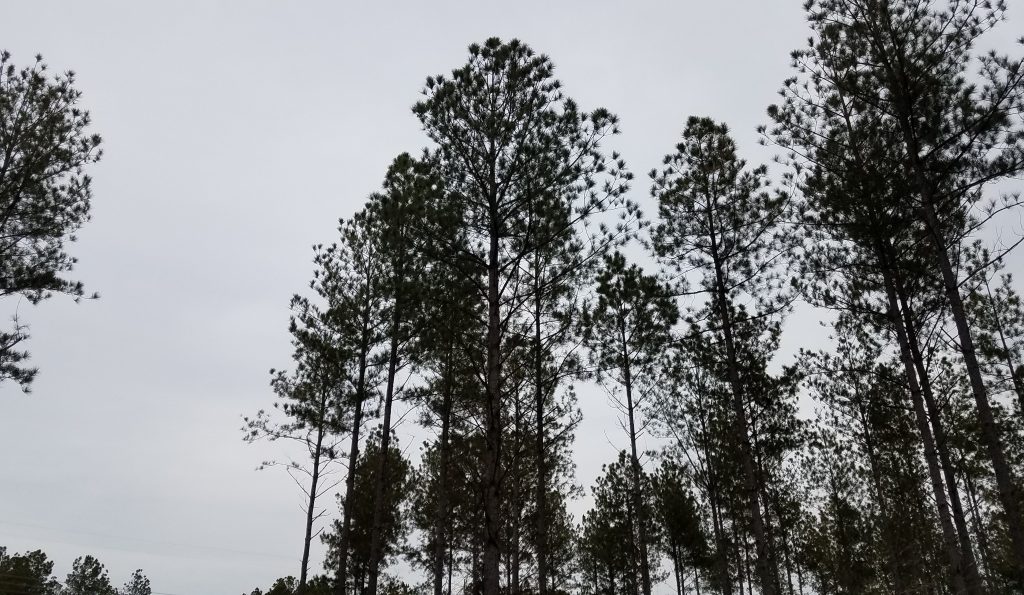
I know my land like I know that back of my hand, and if you ask me to describe the back of my hand w/o looking at it, I cannot tell you in any detail. Today I did a some cutting, some scouting and some marking.
Our December prescribed fire is less than a month away. I am preparing by making lanes, so that we don’t get stuck in the brambles and the fires can be more easily directed. I admit that I maybe am getting a little carried away, since I like to use my cutter. I am also cutting around and marking bald cypress, since I do not want the fires to kill them.
It is much easier to find them now, since they have are in their rust red fall colors. I am pleased to find more than I thought there were. There are some very little ones that I planted last spring and the bigger ones that Eric Goodman planted in 2012. The older ones are almost sure to survive if I give them a little help. I will need to be very careful with the new ones.
Speaking of not knowing the back of my hand, i.e. my land, I had to scout along the edges of the SMZ. Our plan is to let the fire drop into the SMZ, where it will die out, maybe doing a little good by clearing some brush. However, I wanted to be sure that actual streams would be there as the last line of defense, should things not go as we want. I was glad to confirm that the streams form a continuous barrier.
Both belt and suspenders
In an abundance of caution, I want to make a black line along the stream before we do the rest of the fire. I tested the duff. It does not easily burn, which is good in this case. I want to fire to die out when it hits that layer. Of course, I don’t know what the precise conditions will be o/a December 9, but my assumption is that it will not be that different.
I think the land is ready and there is not much more that I can do to prepare. Hope to make is easier for Adam Smith and DoF. In fact, it might be better for me to leave it alone now. It like playing a video game. As soon as I get one thing done, another seems to show up. But I am at the point of very diminishing returns. I can clip now, but I will be clipping what the fire will get anyway.
It will be great to see what wildflowers come up after the fires. After the 2017 fire, it was really fun to see the succession of wild fire regimes. It should be even more interesting now that we have added more variety of seeds. And I have new seeds to spread – some I gathered and others I bought, so we will have the full panoply of forbs and flowers.
My picture is are trees against the sky this morning. There was a woodpecker in the tree, but the picture could not catch it. I think the picture looks artistic anyway.
Food through my ages
What food did you like and how has it changed? – My story worth for this week.
I grew up in the days of Wonder Bread and Oscar Meyer wieners and simple foods in general. Milwaukee in the 1960s was not a mecca for a variety of foods, at least around where I lived. We did not even have a McDonald’s until I was in 10th grade. I tried my first Chinese food when I was already in college. I don’t know if you can call Taco Bell Mexican food, but my first exposure to that sort of food came when I was about sixteen.
Simple foods to start
My mother’s food was good, but simple – meat and potatoes, although never steak. I had my first steak when I was in college. Pot roast and pork chops were our main meet dishes, along with beef stew and backed chicken. We had a lot of spaghetti, Kraft Dinner (macaroni & cheese) and lots of potatoes – mashed, backed and scalloped. My mother’s spaghetti was very simple and not very Italian. Meat with tomato sauce. My cousin married an Italian woman, Irma, and when they lived upstairs from us, I got very good spaghetti. This was when I was already in college, however, and would come home on visits. I admit that I made sure my father told Irma when I would be home, so that I would have her great spaghetti waiting. I have a story about her that I think is funny. Good thing about spaghetti is that it is as good, better maybe the second or third day.
Salamander in the basement
It is not so much about her as the situation. I had a pet, a red and black salamander. He lived in a terrarium in the basement. I forgot to put the top on right one day and he escaped. I couldn’t find him and presumed him dead. Later, must have been years later because I was off at college and on a visit home, my father told me that he “wondered about” Irma. “Wondering about” someone was his code for saying that he thought they were acting crazy. He told me that Irma claimed to see big lizards in the basement. Milwaukee is a northern city. We do not have big lizards just crawling around like in some places in the south. I asked Irma about that lizards next time I saw her. She said it was red and black and ran off when she saw it. She ran off too, so she was not sure where it went. I never did find this “lizard” but I think it was my salamander. Those things can live twenty years. Our basement was not what you would call “finished.” It still had a dirt floor in some places and the water pipes dripped (my father and grandfather had put them together and there was never a time when they were not drinking beer while they did the work). There were lots of spiders down there, so I presume lots of whatever it is that the spiders were eating. I expect a salamander might feel at home in an environment like that.
The best sausage in the world
Milwaukee has the best sausage in the world, and I learned to love, and still do love bratwurst, liverwurst & kielbasa. Most of our vegetables came in cans and I still like canned peas better than fresh ones and I like canned peaches, but I am not fond of “real” ones. I don’t like the peach fuzz.
College food: good and cheap, well cheap
I stayed in the dorms as an undergraduate and had the meal plan. My father paid for it (thanks, Dad). I kind of like cafeteria food, but it was not really very good much of the time. Breakfast was good. You could get eggs and ham or bacon. I liked that. I was lazy my first years in college, so I did not wake up early. Sometimes, however, I would get up early to get breakfast and then go back to sleep.
My budgets were much more constrained in graduate school, since I was on my own. With no meal plan, not much money and no cooking skill, I ate mostly baked potatoes and beans. I used to bake up a whole pan of beans on the weekend and then eat them the rest of the week. It is very cheap and so monotonous that you are not tempted to overeat. I lost maybe fifteen pound my first months at University of Wisconsin. My haggard appearance alarmed my father when I went home for a visit. He made sure Irma made extra spaghetti and some lasagna that I took back with me.
McDonalds
It was also during that time that I worked at McDonald’s. I worked the lunch rush. In addition to the big bucks they paid me for working there, I got a free meal. If you worked up to four hours, you got a small sandwich (hamburger of fish sandwich), small fries and a coke. My colleagues usually made sure my small fries were filled tightly and you could fill up Coke as many times as you wanted, so it was sufficient for my needs. I worked at McDonalds for nine months and then quit because they would not give me a $.05 an hour raise. They said I had the wrong attitude, didn’t take the job seriously enough.
The boss said that if I didn’t like it, I could quit. He seemed surprised when I walked out. By then, I was also working delivering mail and running errands at the History Department. Between the 20 hours at McDonalds and about the same at the History Department, I was putting in a full-time job. I wanted more time to study (I was a nerd in those days), so my courageous decision to walk out of McDonalds was not so courageous after all.
I ate things I did not like in quantities I did not want, but sometimes good
Poland – Zurek
One of the most important jobs of a Foreign Service Officer is to eat and drink for your country. This is harder than it seems. Anybody can eat when he is hungry, but it takes a real man to eat when he is full. At official receptions or dinners, I ate things I did not like in quantities I did not want. Our policy was to eat whatever the host gave us and claim that you loved it. Sometimes – often – the food was very good, but not always. You could get used it, however. There is a kind of sour soup you get in Poland called Zurek. I detested it the first time I tasted it. Continued exposure moved me to tolerate it, and by the time I left Poland I looked forward to getting Zurek. Now I miss it. Zurek is hard to come by in the USA. Most Americans have not gone through the learning process I did.
Norway – Lutefisk
Lutefisk is something I never got to like. They eat that in Norway and also in Norwegian communities in Wisconsin, so I was forewarned. Lutefisk is a kind of decomposed codfish. It has a kind of gelatinous texture, bad taste and strong and unpleasant smell. Norway in the old days was a poor society, with long winters and sparse rations. My guess is this kind of thing was at the bottom of the barrel and everything tastes good when you are really hungry. After a while, they made a virtue out of necessity and called it a delicacy. I guess I never gave it the chance I gave Zurek. Of course, Zurek was commonly served. Lutefisk was reserved for special occasions, thank God.
Brazil – Churrasco
Brazilians have churrasco. This is great. The main drawback is that it is too good. It consists of various cuts of meat, mostly beef, served on spits. It is all you can eat, and I learned to eat a lot. My favorite was something they call picanha. I think it is a rump or flank steak. The grill it on an open fire with lots of salt and then cut off thin slices, cooked crispy on the outside and still rare on the other side. They have these places now in the USA too. Near us are “Fogo de Chão” and “Texas do Brasil.” I would eat at those places every day, if I knew it would not soon kill me to eat so well.
Iraq – Goat grab
The Iraqis used to invite us a lot of “goat grabs,” where you had sheep or goat barbecued and put on a bed of rice. It tastes great, but I was less enthusiastic about how you eat it. They put it in the middle of the table, and everybody gathers around, ripping off pieces with their hands. I don’t mind using my hands, but as an “honored guest,” others rip off pieces and give them to you. You have to eat, bad form to turn it down. I always assumed (hoped) that everybody’s hands were reasonably clean, and I never got sick, so I figure it must have been okay.
There was a lot of good fellowship at the goat grabs. My translators were often behind the curve. A guy would say something evidently important and sincere, talking for a while. The translator would say something like, “he says the goat if fresh.” My several sentence replies were also distilled into a short phrase in Arabic. I am not sure communications were as well served as the goats. Even though I often could not understand what the others were saying to me, they seemed happy and friendly.
Good translation saves my life
Speaking of translators, my best was a guy called Sam Said. He got all I said and more. I may owe him my life, as he talked us out of a dangerous situation with an angry mob in Rutbah when I made the mistake of moving around a couple of parked cars in the market, leaving my Marines very close but so far away. I listened intently, smiled when it seems appropriate and answered questions, but Sam supplied all the cultural lubricant. Lucky, I had my best man with me. Meanwhile, the Marines were getting very nervous. “Sir, get the hell outta there.” I told them that I sure would like to do that but, I figured the safest way out was forward. It ended well. The guys were aggrieved by their treatment by local authorities. They had more trust in Americans and their anger drained with every second we listened. I told them I would inquire, and I did. I followed up a week later. The local guys told me all was okay, but I admit to having no independent way of knowing.
In Heaven there is no beer, no beer in Iraq either
A big problem in Iraq is that there is no beer, at least we were not allowed to have any. As friends know, I am fond of beer, but that is not the reason I missed it so much in Iraq. Beer (vodka in Poland, aquavit in Norway or Cachaça in Brazil, actually beer in those places too, or other alcohol) is a social binder. You drink to others, toast their virtue or just mention some commonality. I suppose you can hold up a piece of meat and say, “this bite is for you,” but it lacks.
These days, I often revert to old form. Today, for example, I will bake up a few potatoes and we will have potatoes and vegetables.
My first picture is me cooking at the Embassy for our “Burgers w/o Borders,” the event where we launched our participation in “Science w/o Borders”. Eventually, around 30,000 young Brazilians went to the USA to study in STEM. Next is a churrascaria in Goiania. Picture # 3 is a goat grab in Haditha, Iraq, followed by a picture of Polish bison vodka. Last is Arthur Treachers, the now defunct fish & chips place. I liked it a lot, but stayed with it when the quality dropped.
Using forests to reduce CO2 works IF we harvest wood to build with wood
There is important nuance here. Mature forests store carbon, but they do not, on balance, capture much from the air. This is because decay balances growth in a mature forest. Forests may be the “lungs of the world” but mature forests produce about as much CO2 as they take it. It has to be this way, else forests would have long since absorbed all the CO2 in the atmosphere and ended life on earth as we know it.
Life giving CO2
We NEED CO2 for life to go on as much as we need oxygen. We just need rather less of it at this time.
How can planting trees take carbon out of the air? The short answer is that – on balance – they can’t. What? A lot depends on the conditions and what happens after.
Coal is fossil wood
Consider how coal was formed. Millions of generations of forests used the power of sunlight to convert billions of tons of CO2 into wood. Wood is about 1/2 carbon by dry weight. The key to forming fossil fuels is that the wood did not decay. Over time, geological forces pressed it into coal. Fossil fuel – coal is wood that did not decay in distant past epochs. When we burned that coal, we released the energy of billions of sunny days and also that carbon that had come with it.
It is a problem, but the thought of coal is awesome and poetic in its own way. What are our current prosaic options?
Forest life cycle matters
A mature forest stores, but does not capture carbon – on balance. I am going to stop saying “on balance,” so please just assume it going forward. A young forest captures carbon but does not store much of it. Most American forests these days are middle aged. They are transitioning from young to old because of the peculiar way they grew. There was a big forest regeneration in the early & middle of the 20th Century. These trees are now reaching maturity. I could go into that interesting story, but I need now to stick to this one. The thing to remember is that America forests have been capturing carbon for the last century but they are at the point where they will stop doing that.
Don’t let nature decide
If we “let nature decide,” nature will choose to release more carbon from our forests, given the age structures. (BTW – there really is not let nature decide option. Our choices are good human choices of bad ones.) But we have a wonderful option open to us, one that will allow carbon to be stored for another century, will keep our forests young growing and healthy and keep them capturing carbon. All the while this is going on, it will make our built environment more ecologically friends and more human friendly.
If we responsibly and regeneratively harvest our forests in ways that respect the forest ecosystem, we can continue to store carbon in roots and soils. This has the added advantage of improving soil texture, making it better able to absorb and hold water helping protect our drinking water and avoiding floods. It also helps us to prevent disastrous wildfires, landslides and just makes everything better.
The next step is to use the harvested timber to replace less environmentally benign options in building, materials like concrete and steel. Let’s be clear. Wood cannot replace these materials in all way, but in a lot of cases it can.
This is a virtuous cycle. There are wonderful benefits and literally no important costs (I will say again here on balance.).
Some references
Environmental costs of concrete
Wood replaces concrete and steel
Finding the little longleaf
Thank you Mariza, Brendan, Alex, Colin, Espen, Andrea & Chrissy for planting longleaf for me last winter. I went looking for them with my cutter today on the farm, i.e. I cut around some of them so that I could see them better.
It was nearly impossible to see them, since they are in the grass stage and they look like … well … grass. But now that the grass is brown you can see the green longleaf.
We got these trees from Aaron Bodenhamer/ Louie Bodenhamer and will get the next ones there too. All the Longleaf on the Freeman place are from Bodenhamer farms.
Burn then plant
We are planning to burn the week of December 9 (depending on weather). The kids will come down soon after to plant the next few thousand longleaf, but I wanted to show them the green trees. The fire will make them look dead. They will NOT be dead, but it might be depressing to see them that way. We will inter-plant a little, but mostly plant the quarter acres clearings among the loblolly.
Protect the bald cypress
I am a little worried about the bald cypress I planted last spring. They are in the wetter areas, so the fires should not be too hot. As a precaution, however, I cleared around some of them and made a fire line for the rest. Labor intensive, but it makes me feel more secure. On the fire day, I will go around and start the fires at the edges so that it burns out. I think they will survive.
Rattlesnake master
I also gathered some of the wildflower seeds, especially from the rattlesnake master. I will spread them after the fires. Rattlesnake master is not showy, but the bees and butterflies love them. Seeds are not so easy to find, so I am glad I have a bunch. I admit that I like it because of the cool name.
It was a “can’t see to can’t see” day, i.e. I left home in the dark and came back in the dark. I pushed it a little, since I figured that I could find my way back along my cut paths even if it got dark, since there was a nearly full moon.
I took a picture of the moon. It did not come out well, but I included it anyway. The first two pictures are the little longleaf looking good. They spend their first year or two sending down roots. This is the grass stage. Then the grow up fast. They call it the rocket stage. Picture # 3 is one of the bald cypress. I put the orange string on some of them, since they will have dropped their needles by the time of the fire and impossible hard to identify otherwise.
Save forests, cut trees
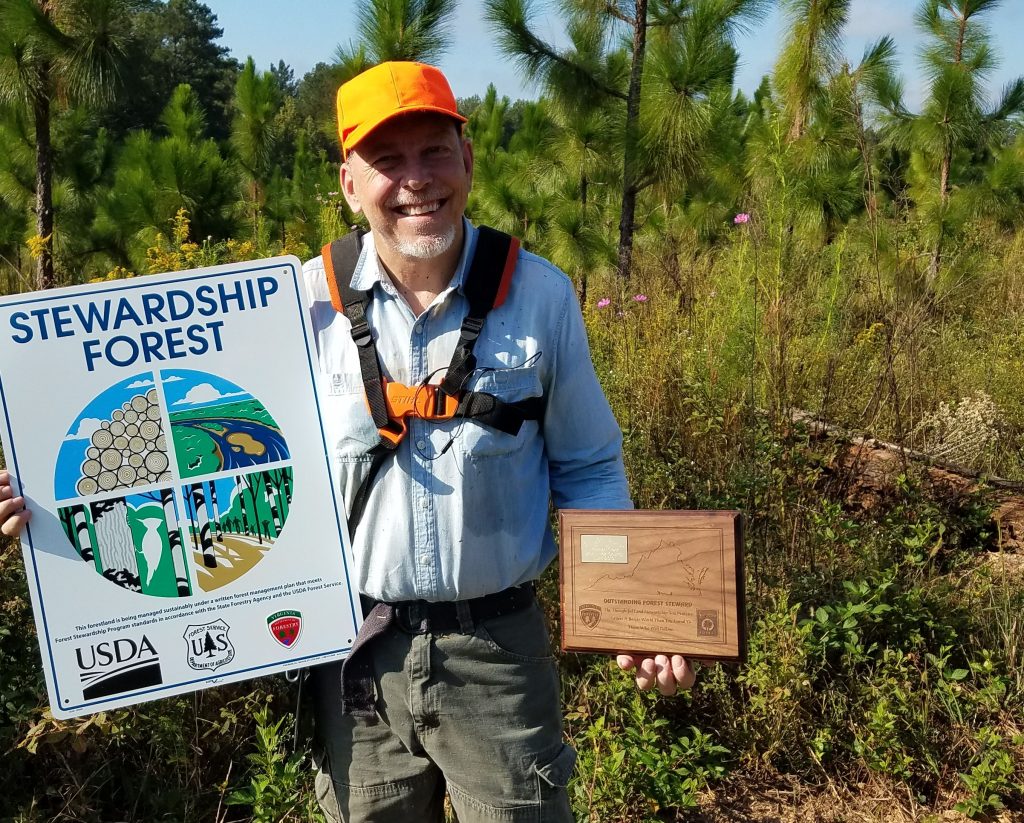
I know that I harp on this, but I think it so important. MOST people got it wrong when they think about forests, harvests & markets. Far from harming forest health, strong markets mean healthy forests and lack of harvests leads to widespread decline, disastrous fires & forest killing insect attack.
Saving paper doesn’t save trees
“Don’t print. Save a tree.” If you have that on your email, you are mistaken. There are good reasons not to waste paper, but these are related to energy costs and use of chemicals in paper manufacture. You do NOT save trees by saving paper. You do NOT save forests by using less wood. Of course, there are nuances.
Harvests and deforestation are not the same things. Deforestation for wood production simply is no longer an important issue in Europe or North America. To the extent that deforestation is an issue at all it results from forest being converted to other uses.
Real threats to forests are not harvests
These days deforestation results from suburban expansion, road building, energy exploration and even for construction of solar farms. And forest ecosystem are destroyed by big fires and insect infestations.
Ironically, the “environmentally aware” guys who build beautiful homes in the woods, using bamboo, recycled wood or even hemp, drive electric cars powered by a nearby solar farm and use that car to drive to protests against forest harvests are much more destructive to forests than the guys operating the chainsaws.
Save forests, use more wood
If you want to improve the health of American forests, you should use MORE wood, stipulating that it come from forests managed according to ecological principles are in harmony with a strong land ethic. This includes most forests in North America. Things are not what they were in the exploitative old days, but people’s perceptions have not caught up.
Preserve some, use some steward all
Think of our American land in three categories. Some places are so unique that we should try to preserve them. I say “try” because nature is dynamic and cannot be preserved, but some places can be stewarded to keep the local environment much as it was in a time we found it or like to remember it. Some places will be used intensively. There will not be much free living nature in the center of a big city, in a mine or under a road. The disruption may be short-lived or long term, but we have to accept these as the cost of our living on earth. Both the preserved and the intensely used make up a prominent but relatively small part of the total land area.
Most land should be stewarded not only sustainably but regeneratively. We have learned to do this in forestry, especially over the last decades and we know how to do it in agriculture, although big challenges remain in implementing what we know and learning more.
Let me emphasize that this is a human hands-on exercise, but one informed by science, experience and land ethic.
I am certainly not content with the current state of forestry. We can always improve and we are always improving, but the way to improve is by being involved, not by standing aside.
And please take that inane saying about saving trees by saving paper off your emails.
What is your best advice when it comes to work?

My story worth for this week – What is your best advice when it comes to work?
The simple short advice is not to do what you love rather to learn to love what you do. Don’t follow your passion, since passion is likely to be short-lived and not likely to be something others will pay you to do.
I understand that some people will see my advice as limiting. I see it completely the opposite. Completely the opposite. It is liberating. Rather than being the in thrall to our passions, we choose and create choices. None of us is “self-made” but we have more to do with what we become than anybody else, so it is better if we act on that.
Young & dumb
I didn’t follow my own advice at first, mostly because I had not yet developed those ideas and was unbelievably stupid. I just didn’t think much about the future. I just found myself in college and I credit my parents with getting me there. They just assumed I would go to college, so I did w/o much thought. I adapted to college but what was supposed to come after, I thought not much about. I didn’t “follow my passion”. I just drifted into studying history because it was interesting, and I could get good grades.
Going nowhere in particular to being nowhere at all
I stayed on this road to nowhere in particular until I realized that it was going nowhere at all. I decided that the quickest way to get on track (I won’t say back on track, since I was never on track) was to get an MBA. My biggest challenge was math. I disliked math and math seemed to dislike me. MBA required calculus and statistics.
Mathematical secret
It was then that I learned a secret of math – it requires more persistence than intelligence. I applied the same methods to math that I had applied to studying Greek – just keep going. I perceived that I could develop competence before I developed comprehension. It is counter-intuitive but there are some things you can understand only AFTER you can do them. This is analogous to learning to love what you do rather than doing what you love. It fits together and applies to many things in life and work.
Out of my depth
I was way out of my element when I got into the FS. FS had lots of unspoken rules. I didn’t know any of them and I didn’t know who to ask, so I observed and read books. This leads me to my next piece of career advice. You need to learn not only what to do but also how to behave. All organizations have culture and we all need to learn how to move in that culture.
All my career, all my life I have felt like I didn’t belong. They call it imposter syndrome. I used to fear it, but I have come to embrace it. My belief now is that if you don’t sometimes feel like an imposter, it is because you are one. My career advice is to embrace it earlier than I did. Understand that you are often playing at levels you think are beyond you, but they are not.
Never complain, never explain
My penultimate piece of advice comes from the FS of older generations. They used to advise “never complain, never explain and never apologize.” Of course, never say never, but there is wisdom in the general paradigm. There are reasons to complain, but don’t you just dislike chronic complainers? Explanations can be useful, but people who constantly explain to justify themselves are never respected. I believe in apologizing when I have done something wrong, but not to wallow in it and to move on to the next step quick as we can.
Nobody is out to get you
My final advice is maybe more an observation. Most of my career I thought the “they” did not appreciate people like me and would not promote me. We all feel put upon from time to time, sometimes most of the time, and we rarely feel treated fairly. If all of us think that, maybe none of us is right, or all we have done is rediscover the human condition. Despite its “obvious” dislike of people like me, the FS promoted me to very high levels. Maybe “rebels like me” are not very rebellious after all. What we do is normal, expected and maybe even useful. So, my final advice is to enjoy life and career. You are doing better than you think and it really doesn’t matter that much in the long run anyway. Get over it.
Sic transit gloria mundi – it seems like a threat, but it can also be a comfort.
Short trip to the forest 2nd day
Early on a frosty morning. It was prettier than my pictures capture. I spent the day cutting around the little longleaf, as you see in the picture.
I cut a path along the SMZ after that. We are planning to burn the middle acres this winter and I want to back the fire down to the little stream, but I also want to make sure that we can get around easily so nothing goes wrong, hence the path. It was mostly clear, since the big trees shade out most of the undergrowth, but I cut through a few fallen trees and lots of green briar. Green briar is like natural barbed wire. It hangs from the trees and can stop anybody trying to walk along the stream side. This is bad enough when you are just walking; it might be a bigger problem when you are carrying a burning jug of diesel/gas mix.
First three pictures are from the morning. The frost made pretty pictures. I planted the little longleaf in picture #1 last year. The loblolly were planted in 2016 and are doing well. Picture #4 is the SMZ. We can burn down to the stream. We did this last year on the other side and it worked well. Last picture is the end of the day. It gets dark earlier now.

